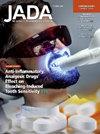Declining US dental amalgam restorations in US Food and Drug Administration–identified populations: 2017-2023
IF 3.1
2区 医学
Q1 DENTISTRY, ORAL SURGERY & MEDICINE
引用次数: 0
Abstract
Background
In light of the Minamata Convention on Mercury and efforts to phase down dental amalgam use, tracking dental amalgam proportions across US Food and Drug Administration (FDA)–identified at-risk populations is of interest to optimize material selection aligned with patient needs.
Methods
A retrospective observational study of Epic’s Cosmos electronic health records data set was conducted to calculate the rates of dental amalgam restorations from 2017 through 2023 and stratified using the social vulnerability index (quartile 4 indicates the highest social vulnerability and quartile 1 indicates the lowest) and payer type (Medicare, Medicaid, self-pay, miscellaneous or other). The authors included the following FDA-identified at-risk populations: pregnant people, children younger than 6 years, people with preexisting neurologic conditions, and people with impaired kidney function (n = 1,897,976).
Results
The overall rate of dental amalgam restoration placements in the general population declined from 21.8% in 2017 to 4.1% in 2023. Dental amalgam restoration trends, according to social vulnerability index quartile and payer type, decreased consistently across all 4 evaluated populations. Of all the social vulnerability index quartiles, quartile 4, representing the most socially vulnerable group, had the smallest decrease in dental amalgam placement rates among the FDA-identified populations examined.
Conclusions
The study results showed a decreasing trend in dental amalgam restorations from 2017 through 2023 among FDA-identified populations, consistent with the Minamata Convention on Mercury directive for a phasedown in dental amalgam use. Notwithstanding improvements, lingering disparities persist among the most vulnerable population.
Practical Implications
Even within the groups identified as most vulnerable to harm, more targeted interventions and strategies are required to improve treatment among the most socially vulnerable.
美国食品和药物管理局确定的美国牙科汞合金修复率下降:2017-2023.
背景:鉴于《关于汞的水俣公约》和逐步减少牙科汞合金使用的努力,跟踪美国食品药品管理局(FDA)确定的高危人群中的牙科汞合金比例对优化符合患者需求的材料选择很有意义:对Epic的Cosmos电子健康记录数据集进行了一项回顾性观察研究,以计算2017年至2023年的牙科汞合金修复率,并使用社会脆弱性指数(四分位数4表示社会脆弱性最高,四分位数1表示社会脆弱性最低)和支付方类型(医疗保险、医疗补助、自费、杂项或其他)进行分层。作者将以下美国食品及药物管理局确定的高危人群包括在内:孕妇、6 岁以下儿童、原有神经系统疾病患者和肾功能受损者(n = 1,897,976):普通人群中牙科汞合金修复的总体比例从2017年的21.8%下降到2023年的4.1%。根据社会脆弱性指数四分位数和付款人类型,牙科汞合金修复趋势在所有 4 个评估人群中持续下降。在所有社会弱势指数四分位数中,代表社会最弱势人群的四分位数 4 在美国食品药物管理局确定的受检人群中,牙科汞合金修复率的下降幅度最小:研究结果表明,从 2017 年到 2023 年,在食品药物管理局确定的人群中,牙科汞合金修复率呈下降趋势,这与《关于汞的水俣公约》关于逐步减少牙科汞合金使用的指令相一致。尽管情况有所改善,但在最脆弱人群中,差距依然存在:实际意义:即使在已确定的最易受到伤害的群体中,也需要采取更有针对性的干预措施和战略,以改善社会最弱势群体的治疗。
本文章由计算机程序翻译,如有差异,请以英文原文为准。
求助全文
约1分钟内获得全文
求助全文
来源期刊

Journal of the American Dental Association
医学-牙科与口腔外科
CiteScore
5.30
自引率
10.30%
发文量
221
审稿时长
34 days
期刊介绍:
There is not a single source or solution to help dentists in their quest for lifelong learning, improving dental practice, and dental well-being. JADA+, along with The Journal of the American Dental Association, is striving to do just that, bringing together practical content covering dentistry topics and procedures to help dentists—both general dentists and specialists—provide better patient care and improve oral health and well-being. This is a work in progress; as we add more content, covering more topics of interest, it will continue to expand, becoming an ever-more essential source of oral health knowledge.
 求助内容:
求助内容: 应助结果提醒方式:
应助结果提醒方式:


